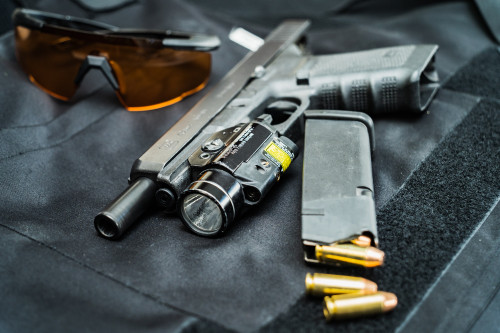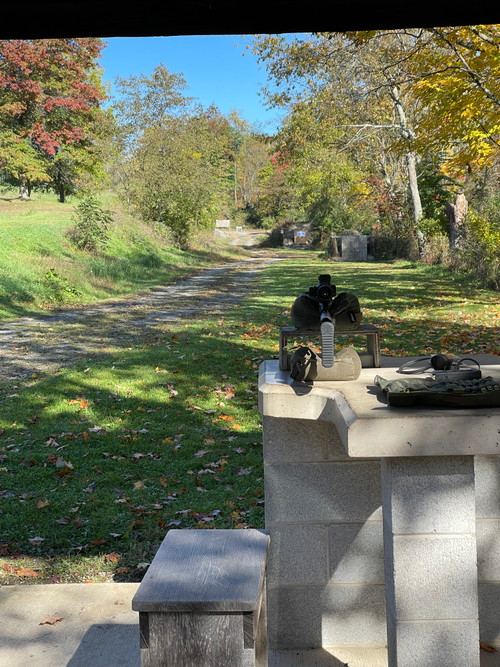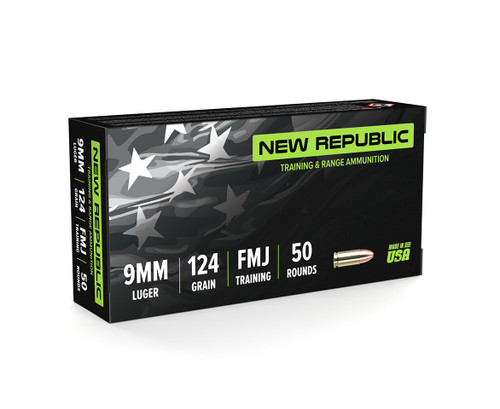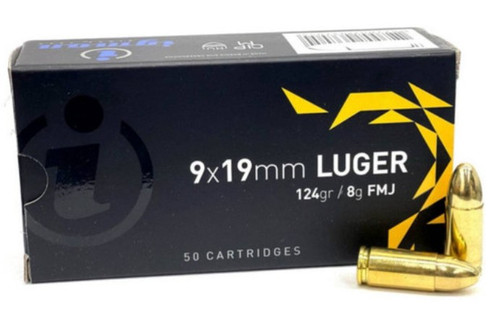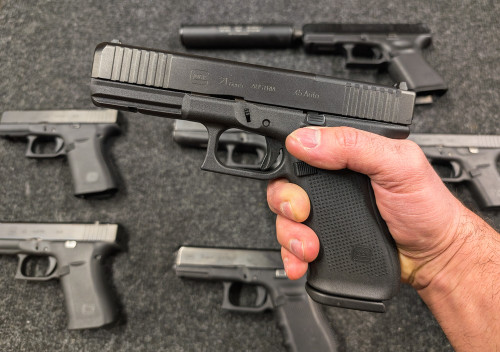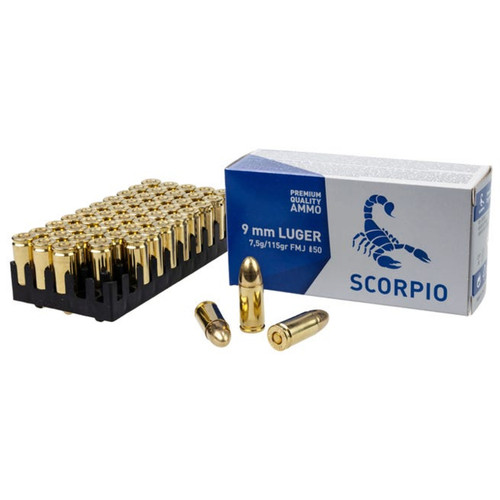Red dot optics are probably the single biggest leap in firearms technology since the invention of the M-16. While optics were once relegated to long-range shooters, the red dot made them up-close and personal.
Red dots were once large and clunky, but advances and technology have made them more compact. Today, you can mount red dots on short-range rifles, handguns, shotguns, and even on subcompact carry guns like Glocks.
The SRO and the RMR, both made by industry titan Trijicon, are two of the most popular micro red dots on the market today. If you can’t decide between them, you’re not alone. Both are excellent choices, but which one is right for you? In this post, we’ll break down some red dot basics, then compare these two optics in a head-to-head matchup.
The Key Players in the Optics World
Before we get too deep into the weeds comparing specific microdot models, let’s look at some of the biggest names in the red dot industry today.
Trijicon
Based in Michigan, Trijicon is sort of the “industry standard” for rifle optics. That’s because they built the US military’s go-to optic for more than a decade: the ACOG. During most of the Global War on Terrorism, US Soldiers and Marines were equipped with the ACOG as part of their standard issue kit.
While the military no longer uses the ACOG, Trijicon maintains a reputation for making sturdy, reliable optics. They’re also the company that makes both the SRO and the RMR, which we’ll dive into later.
Trijicon was the first company to mass-produce red dots for pistols. Sure, serious competitive shooters had been attaching rifle red dots to their pistols since the 1980s and 1990s. But those big, clunky optics weren’t particularly well-suited for anything other than competitions.
Trijicon changed that when they released the RMR way back in 2009 (we’re currently on the RMR 2). Microdots were an instant success, and over the next decade, every major optic company in the world developed their own microdots. Trijicon tweaked their winning design in 2019, and the SRO was born.
Holosun
Holosun is something of the “new kid on the block” in the optics world, but they offer highly competitive prices. As a result, they’re popular among shooters looking for budget-friendly options. The EPS is their latest pistol microdot, while the 510 is a great rifle red dot.
Note that Holosun products aren’t made in the USA. Instead, they’re built in China and then shipped to the US for sale. That doesn’t bother some people, but if you’re a ride-or-die patriot, it may turn you off to Holosun.
Aimpoint
Based in Sweden, Aimpoint developed the very first red dot optics in the 1970s. That sparked the global development of the abundance of red dots we have today. Aimpoints are some of the most durable red dot sights out there. Their PRO (Patrol Rifle Optic) and T-2 Micro are excellent rifle optics, while the ACRO is a high-end (if large) microdot option.
Eotech
Based in Michigan, most of Eotech’s sights aren’t technically red dots. Instead, they’re known primarily for their holographic rifle sights, which function essentially the same as a red dot, but with different technology.
The main advantage of Eotech sights is their big field of view, which helps users maintain high situational awareness. The XPS and EXPS are bomb-proof rifle optics, while their EFLEX model is the company’s attempt to break into the microdot game.
Understanding Red Dots
A red dot is essentially what it sounds like: an optic that uses a red dot to designate a shooter’s point of aim. Red dots offer a huge improvement over iron sights in both accuracy and target acquisition time.
Red dots were once heavy, unwieldy, had short battery life, and featured small sight pictures, but that’s no longer the case. Advances in technology have allowed companies to produce tiny red dots with comparatively large windows that can run for tens of thousands of hours.
What Is MOA?
When you’re shopping for red dots, you’ll see some listed as “2 MOA,” “3 MOA,” or “6 MOA.” This stands for “Minute of Angle,” and describes the size of the dot in the reticle.
Smaller dots are more precise and cover up less of a target, so they’re better for precision shooters or anyone planning to shoot long distances.
However, smaller dots can be more difficult for the eye to pick up quickly. Optics with larger red dots will make long-distance shooting more difficult, since the dot can obscure part of the target. They’re better for close-up encounters, as they’re easier for the eye to pick up and track.
Advantages of Red Dots
As we mentioned earlier, red dots beat iron sights in accuracy and target acquisition abilities. There’s a reason for that.
One major difference between red dots and irons is sight radius. With iron sights, you need to line up the front sight with the back sight and place them over the target. Red dots have essentially infinite sight radius, eliminating the need to line up a front and rear sight. Just point and shoot.
Types of Red Dots
The two main types of red dots on the market today are tube-style and reflex (opened).
- Tube-Style: These look like old-school optics, featuring a long, circular housing that makes them more durable. They’re also usually more accurate out past 50 yards or so, but sacrifice some of a shooter’s situational awareness.
- Reflex: These sights are shallower than tube-style and usually have a boxy design. They can give a shooter a greater field of view and more situational awareness, but sacrifice accuracy at distances above 50 yards. They’re also more fragile than tube-style dots. Some specialized reflex sights are built for specific types of guns, like microdots built for pistols or shotgun optics. Both the Trijicon SRO and RMR fall into the reflex sight category.
Red Dots vs Other Types of Sights
Red dots, whether they’re made by Eotech, Aimpoint, Trijicon, or anyone else, are different from other optics.
For one, red dots don’t feature any magnification. If you want to zoom in with a red dot, you’ll need to pick up a separate red dot magnifier (most red dot companies make these).
Additionally, red dots have extremely simple reticles. Other optics often utilize reticles with features like target leads or bullet drop compensation. In contrast, red dots usually only have a single dot at the point of aim, or a dot and a circle around it.
Trijicon SRO vs RMR: Full Comparison
The SRO and RMR fill a similar niche. They’re great microdots that stand up to a lot of abuse. They’re each solid enough for duty use, and both have top-notch glass clarity. But each has features that make it better for accomplishing different goals. Let’s take a look at some of these contrasting traits.
Trijicon SRO vs RMR : Specs
Here is a quick look at the differences in their specs. For a more detailed analysis of both optics, read on.
| SRO | RMR | |
|---|---|---|
| Design and Construction | 55.88mm x 33.02mm x 35.56mm 46g |
45.72mm x 27.94mm x 25.4mm 34.02g |
| Lens Window (Field of View) | 25mm x 22.5mm | 22mm x 16mm |
| Brightness Settings and Night Vision Compatibility | 8 brightness settings including 2 night vision. | 8 brightness settings including 2 night vision. |
| Battery Life | 3 years | 4 years |
| Durability | 7075-T6 forged aluminum | 7075-T6 forged aluminum |
| Dot Size and Reticle Options | 1, 2.5 or 5 MOA | 1, 3.25, or 6.5 MOA dot |
| Firearm Compatibility | RMR footprint | RMR footprint |
| User Interface | Twist knobs for windage and elevation | Twist knobs for windage and elevation |
| Average Price | $783 | $742 |
Design and Construction
For bomb-proof durability in a compact package, the RMR is the right call. It’s physically smaller than the SRO, clocking in at 45.72mm x 27.94mm x 25.4mm vs the SRO’s dimensions of 55.88mm x 33.02mm x 35.56mm. This means that the RMR won’t “print,” or reveal itself through clothing if attached to a concealed carry pistol.
The RMR is also lighter than the SRO, with each weighing 34.02 and 46 grams, respectively. Using the RMR on a carry gun is more comfortable, since it won’t be tugging your pants down all day.
Just because the SRO is bigger and heavier doesn't mean it’s worse than the RMR, though. Its bigger design makes it better for different applications — notably in competition shooting.
Lens Window (Field of View)
The SRO edges out the RMR in this category. With a 25mm x 22.5mm lens window, The SRO has a larger field of view than 22mm x 16mm RMR. That means a shooter can maintain a higher level of situational awareness, with easier target acquisition.
However, its larger lens window makes the SRO too big for some firearms. If you’re rocking a subcompact gun like a Glock 48, you may want to stick with a smaller optic.
Brightness Settings and Night Vision Compatibility
If you’ve never used a red dot before, you might overlook brightness settings. But the minute you step from inside a building into broad daylight, you’ll understand the importance of this optic feature.
If a red dot’s brightness is too high, the radiant light will drown out your sight picture. If it’s too low, you won’t be able to pick up on the dot with your eyes. Fortunately, each of these optics has 6 different brightness levels. They even automatically adjust their brightness based on ambient light levels.
Night vision compatibility sets premium microdots apart from budget-oriented options. Plus, since the SRO and RMR are two of the best microdots on the market right now, you can own the night with either choice. Each has two different night vision settings to make them compatible with NVGs — if you can afford them.
Battery Life
The battery life for both optics is pretty insane. In a world where you’re lucky if you can keep your iPhone charged for 24 straight hours, the lifespan of a microdot is measured in years.
The RMR’s 4-year battery life does beat the SRO’s three-year lifespan. Both can operate for so long, though, that the difference is negligible. If you have two spare batteries, each of these optics will last you through 2 election cycles.
Durability
The RMR and SRO are both enclosed in a 7075-T6 forged aluminum housing, making them highly durable and capable of withstanding nearly endless abuse. However, since the RMR is smaller (and uses less glass), it can stand up to more abuse than the SRO.
Note that neither of these microdots have a closed emitter design, so the LED that projects the red dot onto the lens is open to the external world. This means dust, moisture, and pocket lint can get in the way of the emitter and block the dot from showing up on the lens. Keep your optic clear!
Dot Size and Reticle Options
The SRO and RMR both have three different dot size options. You can find the SRO with 1, 2.5 or 5 MOA dots, while the RMR comes in 1, 3.25, or 6 MOA variants. Remember what we mentioned earlier. Smaller dots make it easier to hit targets far away, while bigger dots make it quicker to engage close-up targets.
A Trijicon optic is some of the best glass money can buy. The lens clarity on both of these optics puts cheaper microdots to shame. You won’t notice any image distortion, even towards the edge of the lens (where most distortion happens).
Firearm Compatibility
Whether you’re using a Trijicon RMR or SRO, you’ll need a way to fix it onto your weapon.
Microdots like the RMR and SRO usually live on pistols. The best way to attach one to a pistol is by getting a slide without any type of red dot mounting interface and sending it to a gunsmith. They can mill the slide to accept optics with an RMR footprint. Both the RMR and SRO use the RMR footprint.
You can also get “optic-ready” pistol slides, though they may not come with the RMR’s footprint. Typically, optic-ready slides come with one of two footprints: the RMR or Smith & Wesson’s RMSc.
Don’t worry if your pistol doesn’t have an RMR footprint, though. You can buy an adapter plate to attach an RMR to your pistol. Many AK guys use a microdot on their rifles to save weight — after all, AKs are plenty heavy themselves. One of the most popular ways to mount a microdot with an RMR footprint onto an AK is with RS Regulate’s RMR Upper Mount. Note that you’ll also need a Lower Mount as an interface between the gun and the Upper Mount.
User Interface
Both of these optics have a fairly intuitive user interface, each with a knob on either side of their housing. One knob adjusts the dot for windage (horizontal position) and elevation (vertical position). One click of these wheels on either optic will adjust the dot 1 MOA (1 inch at 100 yards).
Once you have your optic zeroed, you can use the “lock-in” feature to disengage the UI from adjusting your point of aim. We’ll fully cover this feature later in this article.
Locking Your Settings
Both the Trijicon SRO and RMR let a shooter “lock-in” or “lock-out” their settings. That means you can also program your settings into the optic’s memory. Here’s how they work.
How to Lock-In
Trijicon RMR and SRO allow a user to “lock-in” their optic’s brightness settings. Typically, these optics have an auto-brightness feature that changes a reticle’s brightness depending on ambient light conditions. If a shooter prefers a specific brightness setting, they can use the “lock-in” feature to disable automatic adjustments.
How to Lock-Out
If you’re carrying a firearm in a holster all day, it may get knocked around. If you bump one of the optics buttons, you may unintentionally adjust your reticle’s brightness or zero. Fortunately, the Trijicon RMR and SRO both allow a user to “lock-out” the reticles’ buttons once they’ve found the right setting.
Making Adjustments
Both the RMR and SRO allow a user to adjust their reticle for elevation and windage. This means you can move the point of aim up or down, which is critical when zeroing your optic to your specific gun.
To make these adjustments, these optics have circular wheels on either side of their housing. Turning the wheels makes an audible click, alerting the user that they’ve adjusted their point of aim.
Holding Zero
“Holding zero” means that once you’ve lined up an optic’s point of aim with a gun’s point of impact, these variables won’t change. Once you zero your optic, you’ll want to put it into “lock-out” mode to ensure you don’t accidentally change your settings.
Final Thoughts
There’s no real “right” answer when choosing between the Trijicon SRO and the RMR. Both are premium microdots that will get the job done. If you need a compact, bomb-proof pistol red dot, go with the RMR. If you want a big sight picture that will make target acquisition easy (and you want to mount it on something other than a handgun), pick the SRO.
Searching for gear can be tricky (and brutal on your wallet if you aren’t careful). That’s why it’s important to find an online retailer you trust to provide you great gear at an affordable price.
At Pro Armory, we offer optics of all shapes and sizes, plus ammo and tactical gear to help you prepare for anything. As a veteran-operated company, we strive to provide an excellent online shopping experience for new and experienced shooters alike. Check out our hot new deals to get the best prices on red dots, holographics sights, and more.






